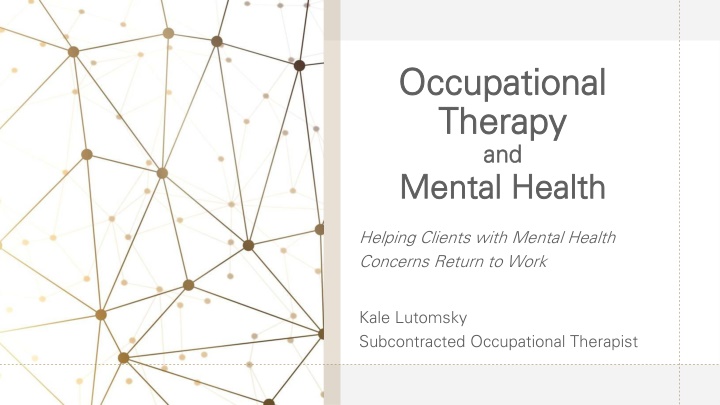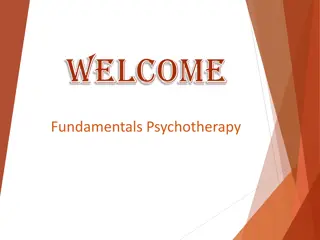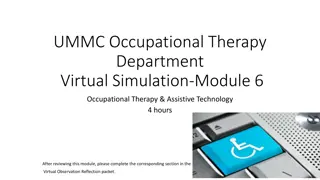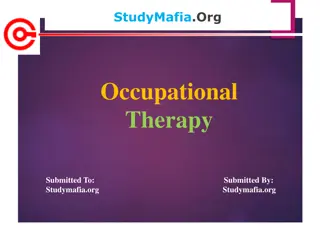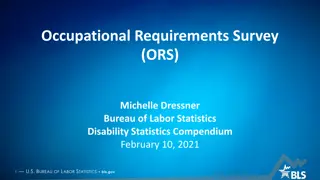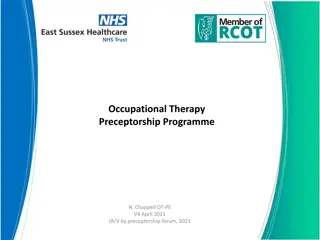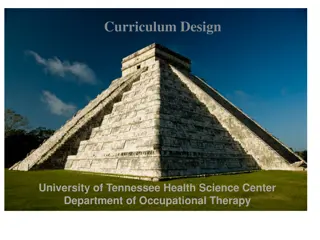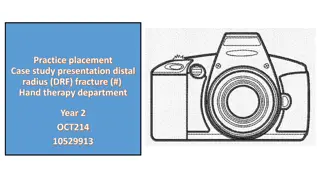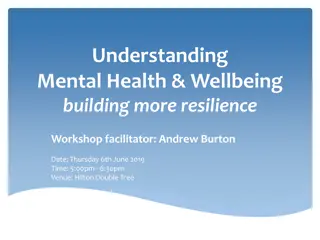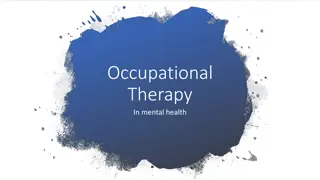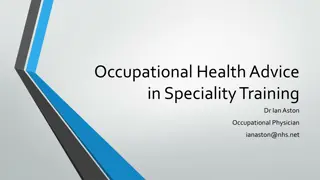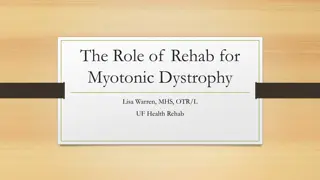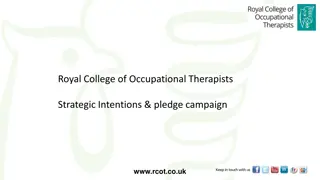Occupational Therapy and Mental Health: Supporting Clients' Return to Work
Explore the role of occupational therapists in supporting clients with mental health concerns to return to work. Understand the concept of occupational therapy, common assessments and interventions used in mental health OT, and how OTs help clients increase independent function. Discover what OTs do in mental health, school systems, hospitals, and the skills they possess from their training and experience.
Download Presentation

Please find below an Image/Link to download the presentation.
The content on the website is provided AS IS for your information and personal use only. It may not be sold, licensed, or shared on other websites without obtaining consent from the author.If you encounter any issues during the download, it is possible that the publisher has removed the file from their server.
You are allowed to download the files provided on this website for personal or commercial use, subject to the condition that they are used lawfully. All files are the property of their respective owners.
The content on the website is provided AS IS for your information and personal use only. It may not be sold, licensed, or shared on other websites without obtaining consent from the author.
E N D
Presentation Transcript
Occupational Occupational Therapy Therapy and and Mental Health Mental Health Helping Clients with Mental Health Concerns Return to Work Kale Lutomsky Subcontracted Occupational Therapist
Roadmap Today, we will cover: 1. What is OT? 2. What role the OT has in supporting their client s mental health 3. Common assessments used by mental health OTs 4. Common interventions used by mental health OTs 5. Application of assessment and intervention techniques to a clinical example
What even is Occupational Therapy? Canadian Association of Occupational Therapists (2022): Occupational Therapy is a type of health care that helps to solve the problems that interfere with a person s ability to do the things that are important to them everyday things like: * Self-care - getting dressed, eating, moving around the house, * Being productive - going to work or school, participating in the community, and * Leisure activities - sports, gardening, social activities. I have a lot to think about =
What even is Occupational Therapy? It s more helpful to ask: What does an OT in mental health do? What does an OT in the school system do? What does an OT in the hospital do?
What even is Occupational Therapy? For OTs, the goal is always to assist the client return to some level of independent function, i.e. increase the client s ability to complete self-care, productivity, and leisure tasks HOW we do this depends on: A) the setting B) the client s concerns C) the OT s extra training / previous experience
What were good at Our schooling and practicums give us: 1.Background in anatomy, physiology, psychology / mental health, and statistics / research 2.Background in mental and physical health counselling and rehab 3.Extensive experience breaking-down tasks (or as we call them occupations ) to better understand thesensation, cognitive, perceptual, affective, and motor performance components of any given task. (We then use these tasks or occupations as a way to assess and treat!)
Human Determinants of Occupational Performance OT6100, 2014-2015 Cooper, Brown, Giesbrecht Performance Components My focus with mental health clients: Cognition Affect
Affect and Cognition: Assessment To assess these two huge domains, a mental health OT could use the following assessments: Affective: Overall status: Personal Recovery Outcome Measure (PROM), Mental Status Examination (MSE) APA DSM-5 Severity Measures: General anxiety, separation anxiety, social anxiety, PTSD, agoraphobia, panic, depression, acute stress, etc. Self-efficacy scales: General, Pain, Cognition, RTW Depression: Beck s, PHQ-9 Fatigue: Mental Fatigue Scale Fear: Fear-Avoidance Beliefs Questionnaire (FABQ), Tampa Scale for Kinesiophobia QOL: WHO QOL, WHO Disability Assessment Cognitive Adult Executive Functioning Inventory (ADEXI) - self report and other report Cognitive Failures Questionnaire Executive Function Performance Test (EFPT) Daily Living Questionnaire FACT-Cognitive Function Memory Awareness Rating Scale Memory Functioning Questionnaire Trail Making Test (TMT) Functional Simulated Tech Tasks (FSTT) - online only Contextual Memory Test (CMT) online only
Affect and Cognition: Assessment but ultimately, it is most helpful to actually see the client complete ACTIVITIES in their home or community environment This is called a Functional Assessment
Affect: Intervention Given how diverse the OT role can be, even when considering the role of an OT in one sub-area like mental health, OTs are trained to conduct a variety of mental health interventions, such as: 1. Dialectical Behavioural Therapy (DBT) 2. Cognitive Behavioural Therapy (CBT) 3. Motivational Interviewing (MI) 4. *Sensory based strategies and rehab 5. Accommodations, adaptive aids, and strategies 6. Psychoeducation
Affect: Intervention If you re interested in learning more about Sensory Processing and mental health, take a look at this paper: https://www.ncbi.nlm.nih.gov/pmc /articles/PMC6370662/
Affect: Intervention 1. Dialectical Behavioural Therapy (DBT): Goals of this approach: Teach people how to live in the moment, develop healthy ways to cope with stress, regulate their emotions, and improve their relationships with others. Strategies: 1. Mindfulness nonreactive, nonjudgmental awareness of brain and body 2. Distress Tolerance radical acceptance, distracting using activities and memories, change body chemistry (movement, temperature, breathing) 3. Interpersonal Skills Training assertiveness training, boundary setting 4. Emotion Regulation STOP, Opposite Action, ABC, positive self talk
Affect: Intervention 2. Cognitive Behavioural Therapy (CBT) Goal of this approach: Become aware of inaccurate or negative thinking so you can view challenging situations more clearly and respond to them in a more effective way. Strategies: 1. Cognitive restructuring / reframing 2. Guided discovery 3. Exposure therapy / successive approximation 4. Behavioural activation / ADL/IADL activation 5. Role playing 6. Progressive Muscle Relaxation (PMR)
Affect: Intervention 3. Motivational Interviewing (MI) Goal of this approach: Evoke client s own motivation for change, in order to help them change something, e.g. substance use, negative thinking, does not want to RTW, ADL/IADL neglect, etc. Strategies: 1. Engage / build rapport and trust 2. Look for and explore change talk 3. Scale of importance and confidence 4. Cost-benefit analysis 5. Action planning and addressing barriers
Affect: Intervention Transtheoretical Model / Stages of Change Model
Clinical Example 45 year old female client diagnosed with anxiety and major depressive disorder (MDD), experienced the following difficulties at work: 1. Difficulty concentrating on work 2. Forgetting deadlines, work procedures 3. Difficulty completing admin, e.g. emailing staff, calling customers 4. Episodic mood disturbances: Crying or becoming anxious / panicking episodically throughout workday 5. General neglect of ADLs and substantial neglect of IADLs
Clinical Example Assess:(Conduct intake assessment and assess ) 1. Depressive symptoms, anxiety symptoms 2. Daily function 3. Workplace function (if at work) 4. Job duties 5. Current coping skills and supports 6. Work readiness 7. (Possibly cognition I find it s better to ax this functionally at first)
Clinical Example Findings: (Our assessment revealed ) 1. Severe daily experience of depressive symptoms 2. Moderate daily experience of anxiety symptoms 3. Disengagement and isolation from social activities 4. Becomes dysregulated/triggered around mother and brother 5. Min-Moderate work readiness ( Contemplation stage) 6. Some coping skills knowledge some reflective practice and knowledge of CBT 7. Toxic work environment Plan: Possible interventions?
Clinical Example Plan: Possible interventions: 1. Routine ADL and IADL engagement behavioural activation with SMART goal setting. Likely some MI as well. 2. MI re: work readiness progress client from Contemplation or Preparation stage to Action phase 3. Learning additional coping skills: 1. Self-reflection / awareness practices (possible building off CBT knowledge) CBT informed, thought analysis 2. Self regulation skills DBT informed, mindfulness and body awareness 3. Pair mindfulness with CBT progress muscle relaxation 4. Boundary setting and assertiveness training for family members 5. Liaise with CM, and possibly, HR. Also: 1. Possible interpersonal skills training and/or perspective taking exercises 2. Possible realty orienting / expectations management, radical acceptance
Above all else All theories / modalities aside, my experiences and book-learning has taught me that simply taking the time to establish a trusting, supportive relationship with the client is massively therapeutic in itself.
Many times getting buy-in is half the battle! This is why it s so important to take the time to understand the client and answer the many whys they might have. If we don t know why we re feeling the way we are and why doing something will help help us, we simply will not do it.
What I want you to remember 1. OTs use meaningful activities ( occupations ) to assess AND rehabilitate. 2. OTs have extensive training in understanding and assessing various factors which could be impacting a client s function mental, physical, cognitive, social factors, etc. 3. Mental health OTs can use evidence-based treatment modalities such as CBT, DBT, and MI to help our clients regain their independence.
Roadmap revisited Today, we ve covered: 1. What is OT? 2. What role the OT has in supporting their client s mental health 3. Common assessments used by mental health OTs 4. Common interventions used by mental health OTs 5. Application of assessment and intervention techniques to a clinical example
Resources / References Description of CBT: https://www.mayoclinic.org/tests-procedures/cognitive-behavioral- therapy/about/pac-20384610 Description of DBT: https://www.verywellmind.com/dialectical-behavior-therapy- 1067402#citation-9 DBT tools: https://dbt.tools DBT Peer-Reviewed & Published Randomized Controlled/Comparative Trials: https://behavioraltech.org/wp- content/uploads/2018/04/RCT4ModesResearchDatatoDate2016.06.28-new-logo.pdf Description of MI: https://motivationalinterviewing.org/understanding-motivational- interviewing Description of sensory modulation: https://www.ot-innovations.com/clinical- practice/sensory-modulation/the-sensory-modulation-program-for-adolescents-adults/ SI/SP, neurophysiology, and mental health: https://www.ncbi.nlm.nih.gov/pmc/articles/PMC6370662/
Resources / References CAOT: What is OT? : https://caot.ca/site/about/ot?nav=sidebar&banner=1 The Intentional Relationship : Taylor, R. R. (2008). The intentional relationship: Outpatient therapy and use of self. FA Davis. https://ottheory.com/therapy-model/intentional-relationship-model- irm CBT Techniques: 25 Cognitive Behavioral Therapy Worksheets: https://positivepsychology.com/cbt-cognitive-behavioral-therapy- techniques-worksheets/ 17 Motivational Interviewing Questions and Skills: https://positivepsychology.com/motivational-interviewing/
